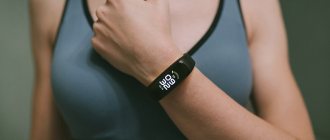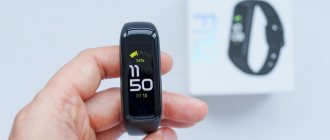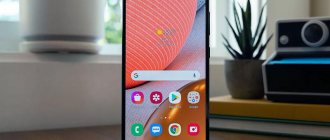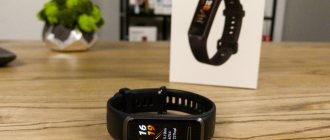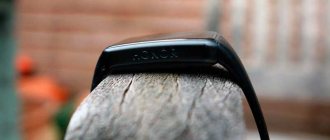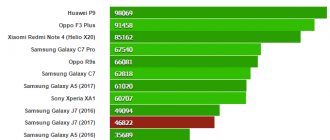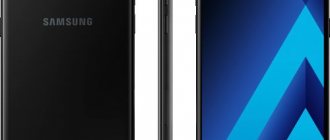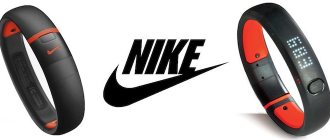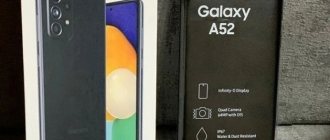Article content
Share the article, help the site!
Samsung Galaxy Fit is one of Samsung's most affordable wearable devices. It doesn't have an unusually large screen like the Gear Fit2, and it doesn't aim for the full smartwatch appeal of the Galaxy Watch. This is the closest thing to Fitbit made by Samsung.
However, it falls short in several areas given its RUB 8,000 asking price. Unlike the Huawei Band 3 Pro and Fitbit Inspire HR, the Galaxy Fit lacks any form of GPS. And poor run tracking using only motion sensors means it's only really good for basic step counting.
Fit looks charmingly minimalist
Design - Samsung goes full steam ahead with Fitbit
The Samsung Galaxy Fit is a fitness band that seems like an obvious alternative to the Fitbit Inspire HR and Huawei Band 3 Pro. They have a classic step counter look. You can wear them every day without people thinking you're training for a marathon or talking about your best running times.
The watch feels better quality than the Fitbit Inspire HR for a few key reasons. Fitbit has a charming minimalism, but it's all plastic. There are some more expensive parts here.
Main characteristics:
- Price: 8000 rubles
- 240 x 120 pixels 0.95-inch OLED screen
- Battery life up to 7 days
- Docking station with wireless charger
- Heart rate sensor
- Notifications
- Bluetooth
The Samsung Galaxy Fit's screen is made of glass, which is less susceptible to scratches from light contact with objects, and the body is made of anodized aluminum.
Samsung Galaxy Fit's glass screen reduces scratches
The Samsung Galaxy Fit has a full-color display, while the Fitbit Inspire HR's is monochrome. It can be concluded that Fitbit has come down a bit in price with its latest updates.
The Samsung Galaxy Fit is as comfortable as almost all fitness trackers in its class. However, it has one of the most uncomfortable and annoying straps.
Samsung Galaxy Fit is comfortable, but its strap is awkward and annoying
You have to hook the end of the band under the other half while it's on your wrist, which starts to feel like a chore unless you plan to wear the Samsung Galaxy Fit 24/7.
I'm guessing Samsung uses this style because it looks good. But I very much prefer the standard Fitbit and Huawei watch-style approaches used in the Inpire HR and Band 3 Pro.
How convenient is it?
I have no complaints about the ease of use of the bracelet. Its rubber strap is comfortable, the clasp is more than reliable and has never come undone. It is so reliable that it takes some time to get used to its design. The bracelet body has almost no sharp edges and does not cling to clothing cuffs. There is also no discomfort in bed and you get used to the shape of the Galaxy Fit easily and quickly.
To control the bracelet, a 0.95-inch diagonal AMOLED touch screen and a mechanical button on the left side of the case are used. The display is covered with protective glass with a rounded shape, the finger glides across it quite easily, and although fingerprints remain, they are in small quantities. In the sun, the display is quite visible, especially at brightness levels from 7 to 10.
Display – The Galaxy Fit can handle bright days if you know how to use it
The Samsung Galaxy Fit features a 0.95-inch OLED screen with a resolution of 240 x 120 pixels. If this sounds like a downgrade from something like Fit2, then you're right. But then again, the Galaxy Fit's starting price is also much lower.
A large piece of black frame around the actual display panel protects the Fit from angled light. Interestingly (well, to some) you can see the edges of the panel more clearly here than on the Huawei Band 3 Pro. This is likely due to the fact that Samsung's screen architecture has more layers that end up reflecting a small amount of light.
The Samsung Galaxy Fit's display is clear, bright and can withstand sunny days
Its maximum brightness can handle sunny days too, although you'll need to manually set this with a swipe and a few taps. A fully automatic brightness mode no longer seems too much to require in an 8k wearable watch, but it is not yet used in bands in this category.
How many watch faces can you choose? There are 24 of them, but since most of them are variations on a theme, it is more truthful to call them a library of seven.
Two of them have an analog window. Others are digital, with different fonts and information fields scattered around.
The Samsung Galaxy Fit has seven different styles to choose from, each with different color options
conclusions
Samsung approached the line of its new models very logically. The best, most functional fitness bracelets occupy the top price range, but they are also aimed at professional athletes, as well as those who actively and regularly train.
Simpler bracelet options - from the Galaxy Fit series - are aimed at users who simply want to control their physical activity. But they are still very functional and practical, which is why these fitness trackers are easily included in the lists of the best.
We hope that our review of new products from the Korean technology giant will help you choose the right fitness bracelet that will become a reliable companion in achieving new sports records.
Tracking and Tracking for Fitness
Here we come across one of the main problems of the Samsung Galaxy Fit, and it is quite an important one. Considering they're almost double the price of the Fit E, you might assume it's meant for more serious tracking, but that's not the case.
I would buy a Samsung Galaxy Fit just for simple step counting. Treat it like one of your essential fitbits and they won't disappoint you.
You can actively track your activities, including walking, running, cycling, swimming and general gym work. Start a session and you'll see the same stats that expensive sports watches offer.
Samsung Galaxy Fit can actively track activities including walking and running
However, the distance readings in the Samsung Galaxy Fit recordings are not accurate. I took the group on a handful of runs, comparing readings with data from the Fitbit Inspire HR, Huawei Band 3 Pro, and Garmin Fenix 5. Each time Samsung was about 20% lower.
A 5K run becomes a 4K run. And while this may make the marathon you'll be training for easier in the long run since you'll be training for months, it means the Samsung Galaxy Fit is useless for monitoring actual performance.
Why is this so bad? The Samsung Galaxy Fit does not have GPS, this is where the tracker wirelessly steals your phone's own GPS readings via Bluetooth. For the same price, the Fitbit Inspire HR offers connected GPS, while the Huawei Band 3 Pro has built-in GPS.
Samsung Galaxy Fit heart rate readings fit wrist sensor
That alone doesn't explain the bad reading, though. Other brands offer pretty decent distance estimates from ranges that only have an accelerometer and gyroscope, suggesting Samsung hasn't nailed down its algorithms yet. Samsung's most recent wearables had GPS or Connected GPS, reducing the need to develop robust tracker algorithms.
No GPS also means no maps of your runs. I like to look at things, although I tend to run in the same places over and over again.
This also means that the Galaxy Fit is not a significantly better tracker than the much cheaper Galaxy Fit E. It looks better.
Samsung Galaxy Fit records your heart rate measurements in the Galaxy wearable app
After this miss, there's something nice about the Galaxy Fit's tracking. Its step counter readings are absolutely accurate, and its heart rate readings are quite consistent with the wrist sensor. Dig into the Galaxy wearable app and you'll see the ability to monitor your heart rate frequently or continuously.
The Samsung Health app, which stores your data, doesn't allow you to drill down into the finer details of your heart rate and so on. But the application is quite nice and attractive. You can also use it to track your weight, water intake and sleep. As with Fitbit, there are also online challenges that will allow you to get motivated without having to rely on a group of friends also using the app.
The Samsung Health app doesn't show fine details, but it's well designed and easy to use.
Protection
Get one step closer to achieving your goals. Galaxy Fitⓔ is certified to military standards and is 5ATM waterproof (up to 50 meters*), which opens up new possibilities for training. From water sports to rock climbing, a fitness tracker will keep you active
*Galaxy Fitⓔ can withstand being in water at a depth of up to 50 meters; The bracelet is ISO 22810:2010 certified. This does not mean that it can be used for diving or water sports involving exposure to strong water jets. If water gets on the bracelet or hands, the bracelet should be dried and only then continued to be used. Meets US military standard MIL-STD-810G
Samsung Galaxy Fit interface and features
Samsung Galaxy Fit's own interface is quite simple. You swipe right and left to switch between different interface screens, which Samsung calls widgets.
Samsung's companion app allows you to change their order, and you may want to do this since swiping through this interface feels a little stilted. I couldn't figure out why until I compared the Fit to the Huawei Band 3 Pro, whose software has been in development for several years.
It's a gesture-based interface, but it doesn't look the same because the different pages are separate states connected by animated transitions (that's the impression you get anyway). There's no sense of inertia that you get with an Android phone or even a Huawei Band 3 Pro.
The Fit's interface is quite basic and not as user-friendly as other fitness trackers at this price.
This is a cost issue, much like the GPS issue. Pay more money and you enter the realm of sleek wearables, and the Samsung Galaxy Fit doesn't offer either.
Samsung Galaxy Fit monitors your stress levels by measuring your heart rate and tracks your sleep. One of the other widgets tells you the weather at your current location.
Samsung Galaxy Fit can also handle notifications. You can select the apps that receive the pass, and the vibration motor will hum a little when they arrive. The app also allows you to customize behavior, so you can choose to block them while actively using your phone, for example.
This is typical notification handling for such a small group. You can only read one message at a time, such as with WhatApp, and you cannot read multiple notifications in a mini-stream. The Galaxy Watch Active lets you do this, although competitors Huawei and Fitbit don't. Of the three Huawei/Samsung/Fitbit options you have for the price, Samsung's notification handling seems to be the most polished.
Display
The displays of the models differ greatly. Galaxy Fit screen resolution is 240 × 120 pixels. It is colored and made using AMOLED technology.
The Fit E has a monochrome PMOLED display with a resolution of 128 × 64 pixels. Due to the flickering frequency, the screen image in the photo is incomplete, but in real life it is displayed correctly.
Samsung Galaxy Fit Battery Life
Samsung claims the Galaxy Fit's 120mAh battery lasts up to seven days. This seems to be based on the fact that some of the more advanced features have been disabled, such as the always-on workout mode and always-on step tracking.
However, I still see about four to five days of use between charges, which immediately gives it a clear appeal over the two-day Samsung Galaxy Fit Active. The Galaxy Fit E has similar requirements.
To put this in a broader context, I believe that the Fitbit Inspire HR lasts less, around three to four days. And Huawei Band 3 Pro can last a whole week without any problem. The lifespan of a Huawei depends largely on how much you use its GPS. It can drain the battery in seven hours as it is quite a power-hungry feature.
The Samsung Galaxy Fit uses a small wireless charging dock. It is contoured and magnetized so it holds the tape in place quite securely.
The Galaxy Fit's battery will last four to five days, but it takes several hours to charge
Battery and autonomy
Samsung claimed that a single battery charge can provide up to 21 days of battery life. But this is only if you look at the time several times a day and the bracelet will count your steps. With more or less intensive use, charging will last for 9 - 10 days, and without constant monitoring of heart rate and stress - for 12 - 14 days.
There is no need to remove the strap to charge the battery. It is enough to attach a proprietary charger to the bottom of the tracker, a USB cable to it and connect it to a power source for about an hour and a half.
